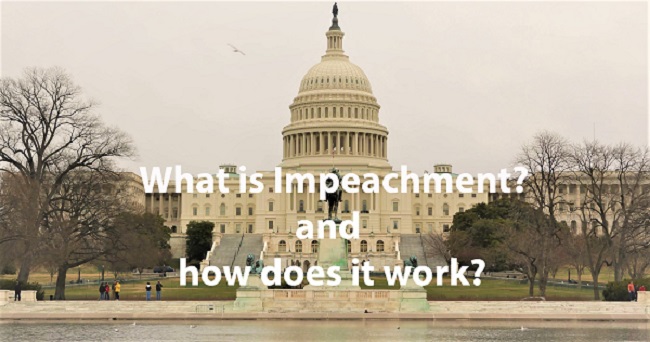
Impeachment is a process were leaders are fired or removed from the government office. Impeachment does not in itself remove the government official from office. It is similar to prosecution in Criminal law, which could end in conviction. Where a governing body accuses and investigates how a leader has misused their position and powers. Impeachment allowing parliamentary to vote for removing accused government officials from office. Impeachment originated in England near the 19th century.
In the United States of America for example impeachment at the federal level is restricted to those who may have committed Bribery, Treason, and other higher crime. Impeachment law exists in many countries around the world, like France, Brazil, India, Russia, Ireland, The Philippine, South Korea, Germany, and The United States. But here we’re focusing on the United States of America Impeachment law.
How Impeachment Work In The United States
Impeachment is possible both at the state and federal levels, any elected official may be impeached. Here we only discuss how impeachment works for the highest office in the land, the president of the United States. There are only 4 ways to remove a US President from there office during their term.
The First Way
If the president can pass away. Till now eight US presidents have died while in office, four of those deaths occurred through assassination. The first incumbent president to die was William Henry Harrison in 1841, who died after only a month in office. He was followed by Zachary Taylor in 1850. Abraham Lincoln was assassinated in 1865, followed by James A. Garfield, who was assassinated in 1881. William McKinley was also assassinated in 1901 and Warren G. Harding suffered a heart attack while in office, and died in 1923. Franklin D. Roosevelt died in 1945 and finally, John F. Kennedy was assassinated in 1963.

The Second Way
The president can be impeached, convicted and removed. In this reference, a simple definition of impeachment is that the House of Representatives makes some ceremonious charges against the president for-to quote the constitution “Treason, Bribery, or other high Crimes and Misdemeanors.” But when the people think about impeachment they mean the entire process, including conviction and removal from office, in fact, it means some kind of allegations of crime.
Impeachment is just the starting process for reviewing a president’s actions and determining if those actions fit the clauses outlined in the constitution. Much like a grand jury prosecution an alleged criminal, impeachment starts a process in motion to review and investigate the president’s actions. In US history, not a single US president has ever been removed from office through impeachment. But there are three presidents that have come close. Three presidents have been impeached, President Andrew Johnson, President Bill Clinton, and President Donald Trump.
The Third Way
The American president can leave office during their term is to resign. Till now there only one president has ever resigned in the history of the US. Contrary to popular notion, President Richard Nixon resigned before the House of Representatives could vote on the Articles of Impeachment they had drafted against him. President Richard Nixon was not removed from office, he resigned in 1974.

The Fourth Way
The president can be removed from office is if the 25th amendment is invoked. Under the 25th amendment, there are two methods in which the president may either temporarily or permanently be absolved of power. Firstly, the President can provide the leaders of the Senate and House of Representatives with a written declaration stating that they are unable to discharge the powers and duties of their office. Once the declaration has happened, the Vice President assumes all powers and duties as Current President unless the President provides another written statement declaring that they are ready to resume their duties.
An example of this law in action would be in 2002 when President George W. Bush temporarily assigned power to Vice President Dick Cheney when he undergoes a medical procedure. Section 4 of the 25th amendment discusses the second means of either temporarily or permanently removing the president from office if the Vice President and a most of cabinet members provide the leaders of the Senate and House of Representatives with a written declaration that the President is incapable to discharge the powers and duties of their office, the Vice President can immediately suppose the powers and duties of the office as Current President.

If the President responds with their own written declaration that no inability exists, they can resume the powers and duties of their office. Then within 4 days if the Vice President and cabinet members send a second declaration that the President is unfit for duty, the Vice President again immediately takes over as Acting President. Then Congress must meet within 48 hours regarding this issue. Within 21 days, Congress must vote to permanently remove the president from power.
If two-thirds of members of both the House of Representatives and the Senate agree that the President is unworthy for office, they are permanently stripped of the position, and the Vice President officially becomes President. This clause is for removing power from the President if they suffer from health-related problems and cannot or will not provide Congress with a written declaration. Currently, this option has never been utilized in US history.
How Impeachment does work
If the President has done some questionable things that the House of Representatives feels they should examine. The Judiciary Committee of the House opens an investigation into the President’s actions. Eventually, the Judiciary Committees’ report is enough to stranglehold several members of the House that President should be impeached so that they
With support for impeachment from several colleagues, the Speaker of the House announced that the House of Representatives is going to hold an official inquiry of impeachment into the President’s behavior. How the Speaker declares the official inquiry isn’t laid out in the constitution, they will hold a news conference, send a letter to the Senate, etc. Over the next subsequent days, if not weeks or months, the House of Representatives collects and reviews information regarding the President’s questionable actions.

This investigation may involve holding hearings, subpoena witnesses to testify, reviewing transcripts and files deemed relevant to the proceedings, etc. Once they’ve reviewed any evidence if warranted the House of Representatives, usually the Judiciary Committee, drafts Articles of Impeachment. Technically, the House of Representatives can found out a special panel to handle the impeachment proceedings or skip the investigation and hold a floor vote on such articles without any committee vetting them. The Constitution simply says that impeachment is the privilege of the House of Representatives and does not specify how they conduct the whole proceedings.
Once the Articles of Impeachment are created, the House votes on them. If the article passes by a majority, then the President is impeached. The House of Representatives consists of 435 legislators so if any article receives a vote of 218, the article passed through a simple majority. From there, the US Senate holds a trial to decide if the passed impeachment articles are true and that they rise to the extent of being serious enough to convict the President and remove them from office. The trial is supervised by the chief justice of the Supreme Court.
A team of the legislator from the House, Called ‘Managers’, act as prosecutors while the president has counsel to act as defense lawyers. The Senators serve as a jury. After hearing evidence and closing arguments from both sides and deliberating, the Senate then reconvenes and votes. A supermajority or a minimum of two thirds (⅔) of the Senate must vote in favor of any Article of Impeachment for the President to be convicted.
The Senate consists of 100 members so an easy majority is 51 votes; while a 2/3 supermajority vote is 67 votes. If the President is found blameworthy of any article, they are removed from office and the vice president is sworn in. Till now not a single US president has ever been removed from office through impeachment. But three presidents have come close. Three presidents have been impeached, President Andrew Johnson, President Bill Clinton, and President Donald Trump. A fourth, President Richard Nixon resigned before the House of Representatives could vote against him on the Articles of Impeachment they had drafted against him.
In 1868, during Reconstruction, President Andrew Johnson, who had an underway bitter struggle with Congress over the division of power was impeached. The primary charge against President Andrew Johnson was that he violated the Tenure of Office Act when he was fired Secretary of War Edwin Stanton. While 3 of the original 11 drafted Articles of Impeachment were passed by the House of Representatives, President Andrew Johnson was not convicted and therefore not removed from the office. In fact on each of the 3 articles, the Senate fell short of the required ⅔ majority by a single vote.

In the fall of 1973, an impeachment process began over President Nixon’s role in the Watergate Scandal. In the early summer of 1974, the Judiciary Committee of the House approved three Articles of Impeachment against President Nixon, for obstruction of justice, abuse of power, and contempt of Congress. Before the House of Representatives could vote on the impeachment articles, President Richard Nixon resigned from office on 9 August 1974.
President Bill Clinton was formally impeached in December of 1998, on two Articles of Impeachment perjury to a grand jury and interrupt of justice for his role in suppressing his affair with Monica Lewinsky. The Senate held an attempt then a vote to convict. The Senate vote pretty much divided down the middle by political party and did not receive a supermajority on either article so President Bill Clinton was acquitted. During the summer of 1787 when the Constitutional Convention convened in Philadelphia, the representative spent a lot of time building checks and balances into the government. Enshrining impeachment into the Constitution created a failsafe the US president is not above the law.
The Impeachment Of Donald Trump
The Impeachment of the Donald trump happens on 18th December 2019, when the Democrat-controlled House of Representatives passes the articles of impeachment on charges of abuse of power and obstruction of Congress. Trump was acquitted by the Republican-controlled Senate on these two counts of impeachment on February 5, 2020. President Donald Trump becomes the 3rd president in US history to be impeached.
[…] 18 in 2019, dominated by the Democrats led House of Representatives of the United States an impeachment one against Trump with accusations of abuse of power and obstruction of Congress. On February 5, 2020, the […]